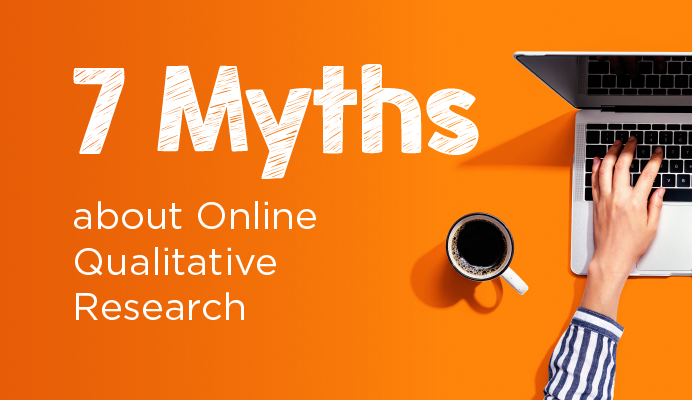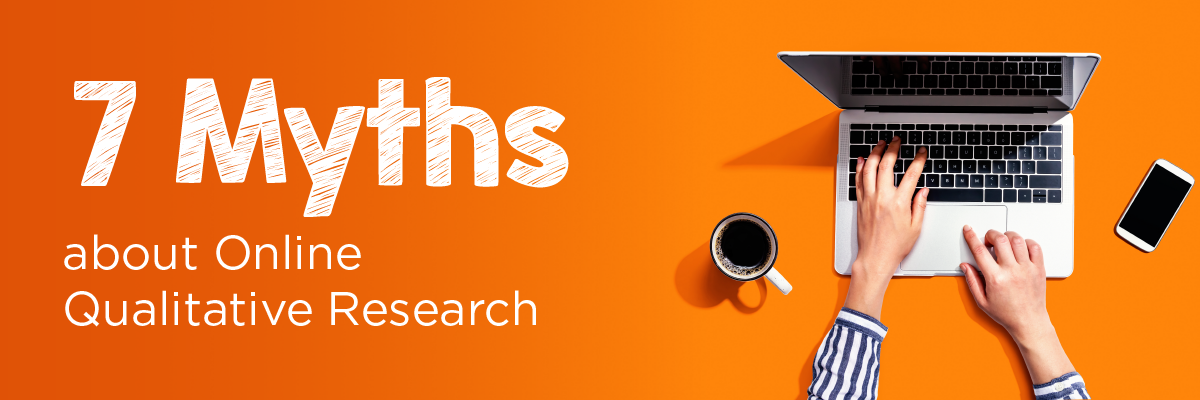By: Ann-Marie Sonmez, APAC Client Manager
Online Qualitative Research has become more popular than ever over the past year, but there are still some widespread misconceptions floating around out there that I’m hoping I can help get cleared up!
Myth 1: I will not get the same quality response as I would with a traditional in-person group.
FALSE! – I understand the fear – in-person interactions have a special quality to them, and people often worry that they’re going to lose some depth when they move these interactions online. The good news is, this doesn’t appear to be true in practice for many projects. In fact, moving your research online can actually improve your insights in some cases. For example, moving online can improve the candidness of responses. Not everybody feels comfortable being completely open in front of others, and being behind a screen can lend that extra courage to be honest. Also, being in the comfort of your own home naturally allows people to be more relaxed.
For projects like product testing and user experience, what better environment to test in than the one you’ll actually be using the product in? Think of it this way – are you really going to prepare a meal the same way in a test kitchen free of distraction as you would at home in your kitchen with the kids and pets running around?
Myth 2. Online qualitative research is just video focus group chats.
FALSE! – One advantage of online qualitative is that you have a wide selection of discussion formats and research methodologies to choose from, so you can pick the platform that works best for what you’re trying to accomplish. For example, you could do:
- Discussion Board which generally runs for a few days, but can run on whatever timeframe is best for your project – from months to years. This platform is perfect for ethnographies and online communities – really any project where you want people to be able to respond at a time that works best for them, and interact repeatedly over a selected timeframe. itracks Board allows a huge amount of flexibility as far as response types, too. You can do video responses, text responses, or a mix of different types of media. You can even make the responses private, visible to the whole group, or uninfluenced, where participants don’t see others’ responses until they themselves have responded.
- Text chat where participants engage in a real-time text-based discussion. This is one of the methods available on itracks Realtime. With text chat, you can have larger numbers of people interacting without having to worry about people interrupting one another, participants can stay anonymous for research on sensitive topics, and you don’t need high internet speeds or a webcam to participate.
Recently, it’s become a really popular platform for research on live events like sports games and political events, since you can keep the discussion going while still allowing people to watch and hear the stimulus. - Telephone In-depth Interviews, or IDIs for short. We often see people use these where protecting a participant’s identity is important, like in health care research. At itracks we have a special platform for this called itracks Phone IDI, which combines the use of telephone audio with online moderation. If the study requires a participant to view media, the participant is able to do so via a computer and is able to discuss any stimuli shared over the phone.
- Video Chat Focus Groups and Video In-depth Interviews allow for a more traditional feel to your research project. These are great for when you want to replicate that in-person experience as closely as possible, and see the faces of those you’re interviewing. This is another method available with itracks Realtime.
Myth 3: There is no backroom so the clients can’t watch the discussion take place, and do not have input while it’s going on.
FALSE! – There are many online platforms to choose from, and not all of them were built with research in mind. All of the itracks platforms mentioned above were built for research, and have “virtual backroom” capabilities for clients to log in and experience the discussion as it happens without interfering or being seen by participants. The observers will not only have the chance to speak to one another, but can also have an open discussion with the moderator to allow more targeted probing questions during the group.
Myth 4: The cost to run an online group is more expensive than a traditional group.
FALSE! – When thinking of traditional research vs online, don’t forget that everyone involved is typically required to travel for in-person groups. These costs skyrocket when you start researching in more than one city, as the moderator and in some cases the clients are expected to go to all of these locations. On top of flights, you have: hotel rooms, facilities, meals, parking, etc., that are required to be covered. And the farther away from home you ask participants to go, the higher the incentive will have to be to get them there. In an online group, moderators, observers and participants are in their own personal space, without the worry of leaving their home. On top of increased safety and saving on costs, you also have higher show rates and less recruiting effort.
Myth 5: There is no possible way to have quality, trustworthy participants because you don’t actually meet them – they could be anybody!
FALSE! – The screening process is quite extensive for online research when you use a quality only qualitative research recruiter, who will vet participants carefully, both to make sure they are who they say they are, and to ensure they meet articulation requirements. With online research, you also have the option to over-recruit in case something falls through last-minute. You can have participants on call for real-time groups in case a respondent needs to be replaced quickly – something that can’t be done in-person. An added bonus is that because you’re removing the travel component, you’re able to get participants who maybe don’t have the means or time to travel, and can end up with a more representative sample. If you’re looking for a pre-vetted online research recruiter, visit our itracks Trusted Partner Network at trusted.itracks.com.
Myth 6: Only Quantitative research can be conducted online.
FALSE! – Almost everyone has, at some point, received a survey from search engines, social media, or stores after you have shopped, so this is often what comes to mind when you think of online research. This is one of the reasons why qualitative research has been overlooked in the past. Quantitative research works for many organizations, but if you are looking for those in-depth responses, or want to uncover something unexpected, it’s time to look into qualitative research. Online Qualitative can often help you understand the “why” behind things that you learn from quantitative, and can also provide you with hugely valuable information that you weren’t expecting.
Myth 7: I can use any technology out there, it doesn’t make a difference if I use a market research tool or not.
FALSE! – I mean, you could, but it will absolutely make a difference as to the quality of your research project. You probably wouldn’t hold a professional in-person focus group at your grandmother’s house, so why would you use software that was designed for chatting with your family and friends to hold a professional online focus group? When you use software that was built specifically for research, you get the features you need to make sure your project goes smoothly, like:
- Virtual Backroom
- Higher security
- Discussion guides
- Enhanced polling and media interaction capabilities
- Reporting outputs designed for research (e.g., single feed video recordings, transcripts)
- Participant consent process
- Automated technical checks
- Plus many more that aren’t listed here.
Have questions? Contact us here, and we’d be happy to chat about getting you started with online qualitative research!

